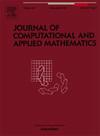High-order bound-preserving finite difference methods for incompressible two-phase flow in porous media
IF 2.1
2区 数学
Q1 MATHEMATICS, APPLIED
Journal of Computational and Applied Mathematics
Pub Date : 2025-04-01
DOI:10.1016/j.cam.2025.116658
引用次数: 0
Abstract
In this paper, we develop high-order bound-preserving (BP) finite difference (FD) methods for solving the incompressible and immiscible two-phase flow problem with capillary pressure in porous media. We use the implicit pressure explicit saturation (IMPES) scheme to solve for the pressure, auxiliary variables, and saturations of each phase in the coupled system. The boundedness of the saturations of the two phases, and , between 0 and 1 is an important physical characteristic. Applying non-physical numerical approximations may lead to significant oscillations in the numerical results and cause instability in the simulation. We apply high-order FD method and BP technique to maintain the high-order accuracy and the boundary of saturations. In the BP technique, the main idea is to choose an appropriate time step and apply positivity-preserving (PP) technique to and , respectively, and ensure that . In addition, the high-order accuracy is obtained by the parameterized flux limiter. Numerical examples are presented to demonstrate the high-order accuracy of the scheme and the effectiveness of the BP technique.
多孔介质中不可压缩两相流的高阶保界有限差分方法
本文建立了高阶保界有限差分(BP)方法,用于求解具有毛细压力的多孔介质中不可压缩非混相两相流问题。我们使用隐式压力显式饱和度(IMPES)格式求解耦合系统中各相的压力、辅助变量和饱和度。Sw和Sn两相的饱和度在0和1之间有界是一个重要的物理特征。采用非物理数值近似可能导致数值结果出现明显的振荡,并导致模拟不稳定。我们采用高阶FD方法和BP技术来保持高阶精度和饱和边界。在BP技术中,主要思想是选择合适的时间步长,分别对Sw和Sn应用保正(PP)技术,并确保Sw+Sn=1。此外,通过参数化磁通限幅器获得了高阶精度。数值算例验证了该方法的高阶精度和BP技术的有效性。
本文章由计算机程序翻译,如有差异,请以英文原文为准。
求助全文
约1分钟内获得全文
求助全文
来源期刊
CiteScore
5.40
自引率
4.20%
发文量
437
审稿时长
3.0 months
期刊介绍:
The Journal of Computational and Applied Mathematics publishes original papers of high scientific value in all areas of computational and applied mathematics. The main interest of the Journal is in papers that describe and analyze new computational techniques for solving scientific or engineering problems. Also the improved analysis, including the effectiveness and applicability, of existing methods and algorithms is of importance. The computational efficiency (e.g. the convergence, stability, accuracy, ...) should be proved and illustrated by nontrivial numerical examples. Papers describing only variants of existing methods, without adding significant new computational properties are not of interest.
The audience consists of: applied mathematicians, numerical analysts, computational scientists and engineers.

 求助内容:
求助内容: 应助结果提醒方式:
应助结果提醒方式:


